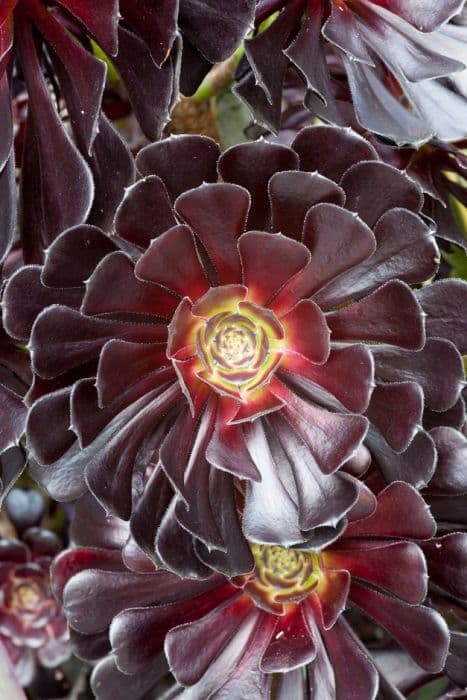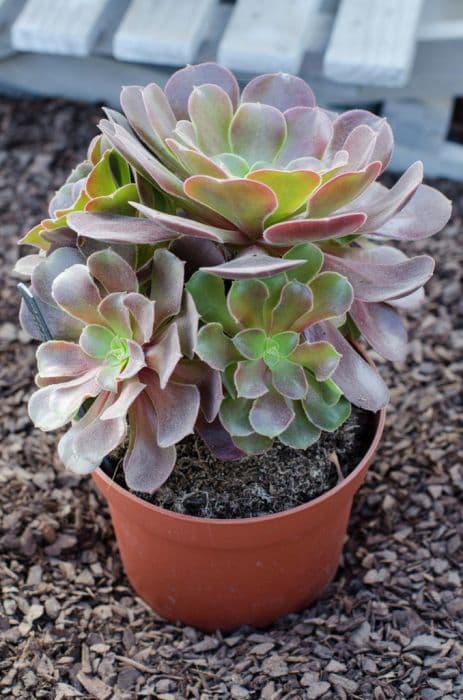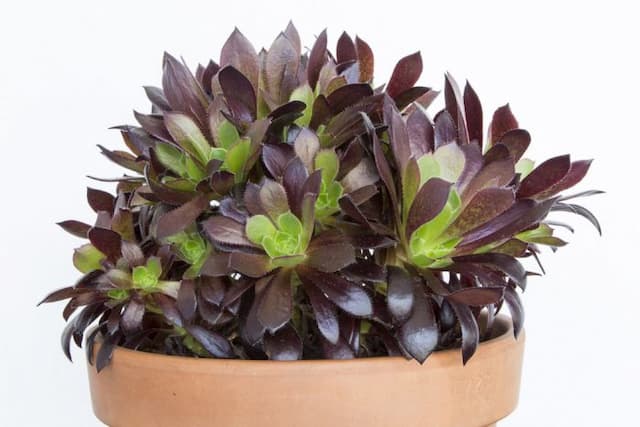Hen and chicks Sempervivum 'Hayling'

ABOUT
Sempervivum 'Hayling', commonly known as Houseleek, has a distinctive appearance characterized by the dense rosettes it forms. These rosettes are made up of fleshy, succulent leaves which are usually green but can have shades of red, particularly towards the tips, adding a colorful contrast. The leaves are thick and pointed, with a somewhat spiky look, designed to retain moisture in their native dry environments. The edges of the leaves often have tiny hairs, which can give the rosettes a slightly fuzzy appearance. These rosettes can multiply, creating a mat-forming cluster that spreads over the surface upon which the plant grows. When in bloom, Houseleeks produce star-shaped flowers on long stems that emerge from the center of the rosettes, adding to the plant's striking appearance. The flowers typically come in hues of pink or red, adding a bright spot of color above the green and red foliage.
About this plant
 Names
NamesFamily
Crassulaceae
Synonyms
Hen And Chicks, Houseleek
Common names
Sempervivum 'Hayling'.
 Toxicity
ToxicityTo humans
Houseleek, commonly known as Sempervivum 'Hayling', is generally considered non-toxic to humans. There are no significant toxic effects expected from the ingestion of this plant. However, as with any plant material, individual allergies or irritations can occur, so it's advisable to exercise caution and keep plants out of reach of small children who might chew on them.
To pets
Houseleek, or Sempervivum 'Hayling', is also non-toxic to pets. It should not cause any serious symptoms of poisoning if ingested by animals such as cats or dogs. While the plant is considered safe, it’s always prudent to monitor pets for any signs of gastrointestinal upset or unusual behavior after ingesting plant material, and if in doubt, consult a veterinarian.
 Characteristics
CharacteristicsLife cycle
Perennials
Foliage type
Evergreen
Color of leaves
Green
Flower color
Pink
Height
0.5 feet (15 cm)
Spread
1 feet (30 cm)
Plant type
Succulent
Hardiness zones
3
Native area
Europe
Benefits
 General Benefits
General Benefits- Low Maintenance: Sempervivum 'Hayling', commonly known as Hen and Chicks, requires minimal care once established, making it ideal for gardeners of all skill levels.
- Drought Tolerant: Its succulent nature allows it to thrive in dry conditions, conserving water and reducing the need for frequent irrigation.
- Cold Hardy: This plant is capable of withstanding harsh winter conditions without the need for special protection or winterizing.
- Evergreen: Hen and Chicks retains its foliage throughout the year, providing persistent color and texture in the garden.
- Ground Cover: It can spread to form a dense mat, which helps to suppress weeds and reduce soil erosion.
- Attracts Pollinators: The flowers of Sempervivum 'Hayling' attract bees and other beneficial insects, promoting a healthy garden ecosystem.
- Easy Propagation: Hen and Chicks readily produces offsets, making it simple to propagate and share with others.
- Versatile Design: With its rosette shape and varied colors, this plant adds unique visual interest to rock gardens, containers, green roofs, and borders.
- Resistant to Pests: Sempervivum 'Hayling' is not often troubled by pests, reducing the need for chemical treatments.
- Deer and Rabbit Resistant: Its succulent leaves are typically unappealing to deer and rabbits, decreasing the likelihood of plant damage from wildlife.
 Medical Properties
Medical PropertiesThis plant is not used for medical purposes.
 Air-purifying Qualities
Air-purifying QualitiesThis plant is not specifically known for air purifying qualities.
 Other Uses
Other Uses- Sempervivums, commonly known as 'Hen and Chicks', can be used as living mulch in garden beds, helping to retain soil moisture and suppress weeds.
- These plants can be planted in roof gardens due to their hardiness and drought resistance, which make them suitable for extreme conditions.
- Hen and Chicks are ideal for creating living wreaths or topiaries, providing a unique and long-lasting green decoration.
- Their ability to thrive in shallow soil makes them perfect for decorating stone walls and walkways.
- Hobbyists may use Hen and Chicks to create miniature fairy gardens, taking advantage of their small size and rosette shape.
- In regions with suitable climates, Sempervivums can be grown as ground cover to stabilize slopes and prevent soil erosion.
- They can serve as natural indicators of the environment; their color may change under stress conditions, signaling excessive sun or water.
- The plant can be used in educational settings for lessons on succulents, adaptation, and survival strategies in plants.
- Hen and Chicks can be part of green art installations, where their texture and variety of forms add aesthetic value to both indoor and outdoor spaces.
- These succulents can be used as natural barriers in gardens to delineate spaces due to their dense growing habit.
Interesting Facts
 Feng Shui
Feng ShuiThe Hen and chicks plant is not used in Feng Shui practice.
 Zodiac Sign Compitability
Zodiac Sign CompitabilityThe Hen and chicks plant is not used in astrology practice.
 Plant Symbolism
Plant Symbolism- Perseverance: Sempervivum, commonly known as "Hens and Chicks," is a plant that can survive under harsh conditions, thus symbolizing the ability to endure and persist.
- Protection: Its rosette form and thick leaves are thought to symbolize a shield against negative forces and bad luck.
- Self-Reliance: Sempervivums are known for their ability to grow without much care, symbolizing independence and self-sufficiency.
- Timelessness: "Hens and Chicks" can survive for many years, often outliving their planters, representing enduring love and everlasting life.
- Renewal: As the "hens" (mother plants) produce "chicks" (offsets), they signify new beginnings and regeneration.
 Water
WaterHen and chicks should be watered sparingly, as they are drought-tolerant plants adapted to dry conditions. The soil should be allowed to dry out completely between watering sessions. Generally, providing a thorough watering once every two weeks during the growing season is sufficient. Depending on the climate and the pot size, you might adjust the frequency, but be cautious not to overwater. A good method is soaking the soil with approximately 2 gallons of water for an outdoor garden area of about 10 square feet, ensuring it reaches the root zone without leaving the plant sitting in water.
 Light
LightHen and chicks thrive best in full sunlight to partial shade. They prefer at least 6 hours of direct sunlight daily, so an ideal spot would be a south-facing location where they can bask in the sun's rays. Nevertheless, if you live in an extremely hot climate, provide them with some afternoon shade to prevent sunburn.
 Temperature
TemperatureHen and chicks are hardy in a wide range of temperatures, managing to survive in temperatures as low as -30°F and as high as 90°F. However, their ideal growing conditions lie between 65°F and 75°F. They are well-suited to outdoor conditions in most temperate climates, but should be protected from extreme winter chill and excess summer heat.
 Pruning
PruningHen and chicks benefit from occasional pruning to remove dead leaves and spent rosettes. Prune the plants in spring or early summer by gently pulling away the dead material to promote better air circulation and growth. They rarely require extensive pruning, and this light maintenance is sufficient once a year or as needed when you notice dead or dying parts.
 Cleaning
CleaningAs needed
 Soil
SoilHouseleek (Sempervivum 'Hayling') prefers a well-draining soil mix composed of 50% potting soil, 25% sand or perlite, and 25% peat or compost. The ideal pH for the soil should be slightly acidic to neutral, ranging from 6.0 to 7.5. This mix ensures proper drainage and aeration, mimicking the plant's native rocky habitats.
 Repotting
RepottingHouseleek (Sempervivum 'Hayling') should be repotted every 2-3 years to refresh the soil and provide room for growth. They are slow-growing plants and do not require frequent repotting, but should be checked yearly for overcrowding and root health.
 Humidity & Misting
Humidity & MistingHouseleek (Sempervivum 'Hayling') thrives in low humidity environments. They are well adapted to arid conditions, and excessive humidity can lead to rot. Therefore, they are best kept in an environment with dry air, avoiding high humidity levels.
 Suitable locations
Suitable locationsIndoor
Place in bright light, avoid overwatering.
Outdoor
Full sun, well-draining soil, protect from heavy rain.
Hardiness zone
3-9 USDA
 Life cycle
Life cycleThe life of Hen and Chicks, commonly known as Sempervivum 'Hayling', begins with seed germination where the plant establishes a small rosette of succulent leaves. The rosette grows and matures, capable of enduring harsh climates due to its drought-resistant nature. As it matures, the Sempervivum 'Hayling' produces offsets, or "chicks," that spread out from the "hen" or mother plant. These offsets root themselves nearby, forming a carpet of rosettes over time. After several years, the mature rosette blooms once with star-shaped flowers, often in shades of red or pink, before it completes its life cycle by dying. The vacant space left by the hen is quickly filled by the surrounding chicks, ensuring the continuation of the colony.
 Propogation
PropogationPropogation time
Spring-Early Summer
The Sempervivum 'Hayling', commonly known as Hen and Chicks, can be propagated by separating the offsets, which are the small rosettes that form at the base of the parent plant. In the spring through the early fall, these offsets can be gently pulled away from the main rosette when they have developed their own roots. Ideally, leaving a small amount of stem on the offset can help when planting them into their own pot. Pots should be filled with a mix suited for succulents and cacti, providing good drainage. Once the offsets are planted, water them sparingly to avoid waterlogging, which can lead to rot. It's important to allow the soil to dry out between waterings. This method is popular due to its simplicity and the high success rate for these resilient and independent young plants.









